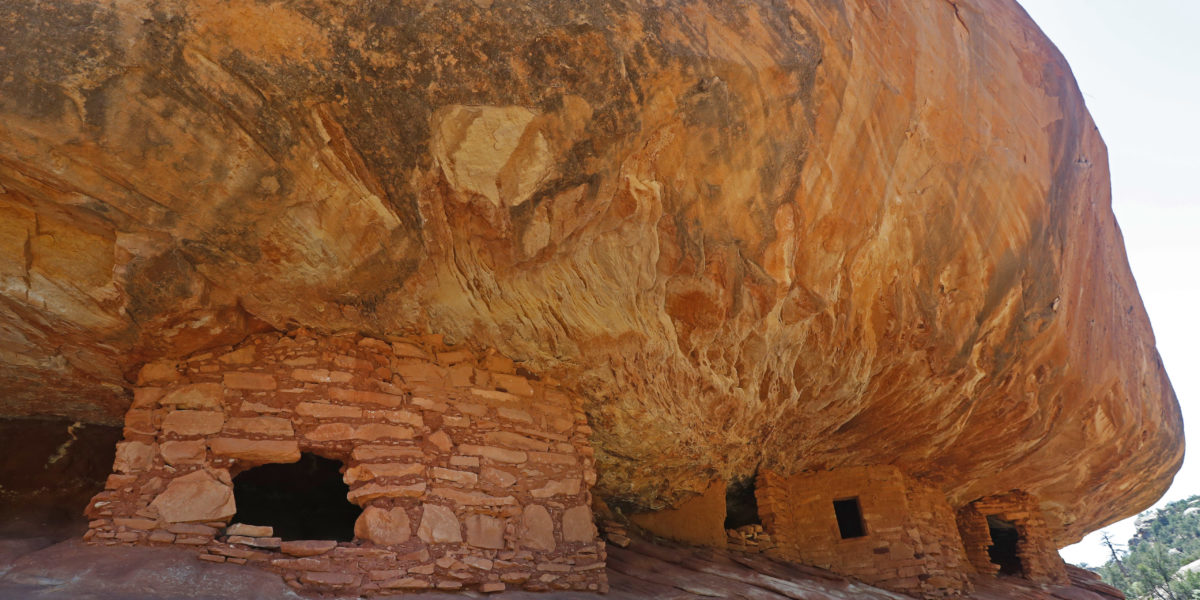
Why Utah’s Bears Ears Should Top Your Adventure Bucket List
The 1.35 million-acre national monument plays host to all manner of outdoor enthusiasts.

George Frey/Getty Images

Protections of over 2 million acres of treasured landscapes in southeastern Utah were at long last restored this past October in a reversal of a 2017 order that slashed the ancestral homelands of the Navajo Nation, Ute Indian and Ute Mountain Ute tribes, Hopi Tribe, and Pueblo of Zuni tribes.
The about-face, which Interior Secretary Deb Haaland called a “profound action … to permanently protect the homelands of our ancestors,” reopened the region in the process to a wealth of outdoor recreation opportunities that had long been part of its martian landscapes. Bears Ears National Monument, a 1.35-million-acre parcel that sits a couple hours south of Moab, has hosted all manner of outdoor aficionados, from hikers and mountain bikers to rock climbers, stargazers, archaeologists, natural historians, and river rafting enthusiasts.
With restrictions rescinded, crowds are bound to flock once more, and likely in even greater number, as domestic travel continues to remedy the lingering effects of our very own annus horribilis.
Look no further for confirmation of our modern-day exodus than the trove of data on surges in outdoor recreation and camping. A staggering 48.2 million United States households camped at least once in 2020. Last year, more than 10 million households set off on their first camping excursion, with many flocking to treasured destinations like Utah’s Zion and Arches national parks, where officials likened the onslaught of crowds to attendance at Disney World.
Fortunately for the discouraged Archers and Zionists, Bears Ears can accommodate. Take our guide below for a spin to ensure your adventure of exploring some of these Utahn jewels for the first time goes off without a hitch. Whatever the activity, you won’t be disappointed.
Hiking, Biking, Horsing Around
Bears Ears has the potential to ignite the sort of adventurous spirit embedded deep within our DNA thanks to towering mazes of red rock, juniper forests, and cottonwoods. And what better way to explore this region than alongside guides whose ancestors have been here for millennia?
Embark on a bike-packing tour of southeastern Utah with the Navajo- and veteran-owned Dzil Ta’ah Adventures; enjoy single- or multi-day backpacking hikes with Ancient Wayves River and Hiking Adventures (with highlights like the House on Fire Anasazi Ruins); or set off on horseback near the Utah-Arizona border with Sacred Monument Tours.
Want more? Canyoneering is an immensely popular (and challenging) southeastern Utah endeavor, incorporating climbing, swimming, and rappelling. In Bears Ears, Fry Canyon is suitable for experienced participants or groups under the charge of a guide. Learn more about Fry Canyon adventure via the Bears Ears Education Center.
A River Runs Through It
Explore the San Juan River by raft courtesy of Wild Expeditions. Trip lengths range from a single day to a week, and include inflatable kayaks, dry bags, meals, snacks, professional guides, and transportation to and from the river.
Float between thousand-foot canyon walls, hike to sites abandoned by Indigenous peoples thousands of years ago or on trails established by gold-hungry miners in the 1800s, enjoy side canyons with hidden springs, waterfalls, and hanging gardens, and fall asleep while gazing into unobstructed dark heavens.
Whatever length you choose, it will no doubt be a welcome departure from the hustle of a technologically-obsessed world.
Rock Steady
Tackle world-class rock-climbing in Valley of the Gods or Indian Creek, where the Christmas Tree route awaits those who dare brave its 140-foot, 5.12+ ascent.
If issues with heights or climbing experience deter, explore cliff dwellings and petroglyph sites, including some that date back 2,000 years, such as Newspaper Rock, where visitors can enjoy signs of Indigenous peoples who called these rich lands home long before the first European settlements.
Personal Space
More than 99% of the U.S. population lives in areas with light pollution capable of drowning out even the most prominent constellations and planets. What’s more, approximately one in every three humans, and nearly 80% of North Americans, are unable to see the Milky Way.
Utah, on the other hand, has one of the greatest concentrations of certified International Dark Sky destinations in the world. Enjoy unparalleled dark skies and astrophotography opportunities in Bears Ears, as well as regional hotspots like Arches or Canyonlands national parks, or Goosenecks, Dead Horse Point or Goblin Valley state parks.
Interested in learning more about everything that Bears Ears has to offer? Check out visitutah.com.
